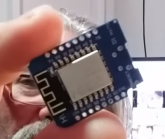svetz
Works in theory! Practice? That's something else
Synopsis
This thread is a journey starting with how to remotely control a humble ceiling fan, but will hopefully grow over time to figure out how to run the hot water heater and charge the eCar when the grid is down automatically using only excess solar power (i.e., only turns some things on when there's excess power available).
Premise
The quest to resolve Light Switch Replacements hasn't been fruitful as I couldn't find a Smart Things type 3 speed fan and light switch that would replace my existing one (one possibly $$ exception). As I was putzing around with the monitoring software to read an Itron RF utility meter via the rtl_sdr it dawned on me the fan controller used RF. ding ding ding!
Technology
Could I use the RTL-SDR dongle to record and playback the RF signals, thereby controlling fans from the computer? Could this be taken farther to control Z wave devices? More stuff to play with in the ultimate quest for the smart solar house. As it turns out the RTL_SDR dongle I have is a receiver and while it does transmit...it's more by accident via leakage so has a very short range.
So hardware ... what's needed for remote control is a transmitter and a controller. There are some commercially available and they use a variety of technologies. From the Smart Solar/Battery thread we have:
Commercial and opensource options are: SmartThings hub, Alexa, Hubitat, OpenHub, a Z stick, Home.Assistant running on an Rpi, or even software running on a pc and controlling wifi devices.
Fan Update: Most fans are pretty easy to handle with standard devices. Who knew this first step would be so hard? The problem with Hampton Bay fans like I have operate at a frequency (303.85 MHz) you can't easily purchase an RF development board or ready to go SmartHome devices for it. There are chips, but haven't seen a 304 MHz SAW. The Bond seems to be the best off-the-shelf solution, it's like a self-learning remote, but it also has an API that let's you control the radio for OOK. So, the devil is in the details, but if this can be conquered DIY fashion anything should be possible.
Acknowledgements: Many of the ideas and links are ideas/input from other enthusiasts from other threads including: tictag, jwu_cc, Steve_S, tim0shel, sunloverjt, and everyone else that has posted about home automation, thank you!
This thread is a journey starting with how to remotely control a humble ceiling fan, but will hopefully grow over time to figure out how to run the hot water heater and charge the eCar when the grid is down automatically using only excess solar power (i.e., only turns some things on when there's excess power available).
Premise
The quest to resolve Light Switch Replacements hasn't been fruitful as I couldn't find a Smart Things type 3 speed fan and light switch that would replace my existing one (one possibly $$ exception). As I was putzing around with the monitoring software to read an Itron RF utility meter via the rtl_sdr it dawned on me the fan controller used RF. ding ding ding!
Technology
Could I use the RTL-SDR dongle to record and playback the RF signals, thereby controlling fans from the computer? Could this be taken farther to control Z wave devices? More stuff to play with in the ultimate quest for the smart solar house. As it turns out the RTL_SDR dongle I have is a receiver and while it does transmit...it's more by accident via leakage so has a very short range.
So hardware ... what's needed for remote control is a transmitter and a controller. There are some commercially available and they use a variety of technologies. From the Smart Solar/Battery thread we have:
- X-10 - uses the house's wiring to send signals. Might have issues as Enphase changes the frequency or interference with powerline communications to inverters. No acknowledgements.
- Z-Wave - 908.42 MHz radio frequency (U.S.), mesh network, doesn't interfere with WiFi
- Zigbee - 2.4 GHz meshed, could interfere with bluetooth and WiFi
- LoRa - Low power and long range
- Bluetooth - poor range
- WiFi - increasing devices decreases overall throughput
Commercial and opensource options are: SmartThings hub, Alexa, Hubitat, OpenHub, a Z stick, Home.Assistant running on an Rpi, or even software running on a pc and controlling wifi devices.
Fan Update: Most fans are pretty easy to handle with standard devices. Who knew this first step would be so hard? The problem with Hampton Bay fans like I have operate at a frequency (303.85 MHz) you can't easily purchase an RF development board or ready to go SmartHome devices for it. There are chips, but haven't seen a 304 MHz SAW. The Bond seems to be the best off-the-shelf solution, it's like a self-learning remote, but it also has an API that let's you control the radio for OOK. So, the devil is in the details, but if this can be conquered DIY fashion anything should be possible.
Acknowledgements: Many of the ideas and links are ideas/input from other enthusiasts from other threads including: tictag, jwu_cc, Steve_S, tim0shel, sunloverjt, and everyone else that has posted about home automation, thank you!
Last edited:






